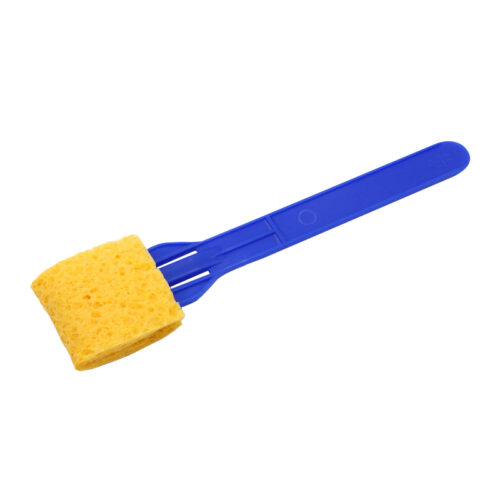샘플링을 위해 셀룰로오스 스폰지를 사용할 때 피하는 일반적인 실수
2025-02-15
환경 또는 표면 샘플링과 관련하여, 셀룰로오스 스폰지는 미생물 및 잔류 물을 수집하는 효과로 인해 인기있는 선택입니다.. 하지만, 결과의 정확성과 신뢰성은이 스폰지를 얼마나 잘 사용하는지에 크게 좌우됩니다.. 안타깝게도, 몇 가지 일반적인 실수는 샘플의 무결성을 손상시킬 수 있습니다., 부정확 한 데이터 또는 오염으로 이어집니다.
이 블로그 게시물에서, 셀룰로오스 스폰지 샘플링 중에 만들어진 가장 빈번한 오류를 탐색하고 피하는 데 도움이되는 실행 가능한 팁을 제공합니다.. 이러한 모범 사례를 따르면, 샘플링 프로세스의 효과를 향상시키고보다 안정적인 결과를 보장 할 수 있습니다..
 Meidike 유전자 셀룰로오스 스폰지
Meidike 유전자 셀룰로오스 스폰지
1. 스폰지를 올바르게 수화시키지 못합니다
가장 일반적인 실수 중 하나는 마른 스폰지를 사용하는 것입니다.. 건조 셀룰로오스 스폰지는 미생물 또는 잔류 물을 수집하는 데 덜 효과적입니다., 이로 인해 샘플링이 낮을 수 있습니다. 이것을 피하기 위해, 사용하기 전에 항상 적절한 완충액 또는 희석제로 스폰지를 수화하십시오..
하지만, 스폰지를 과포화하지 않도록주의하십시오. 과도한 액체는 수송 중 샘플을 희석하거나 재료 손실을 유발할 수 있습니다.. 최적의 샘플 수집을 보장하기 위해 균형 잡힌 수분 수준을 목표로합니다..
2. 오염으로 이어지는 부적절한 취급
오염은 셀룰로오스 스폰지를 처리 할 때 중요한 위험입니다. 맨손으로 스폰지를 만지거나 비체 표면에 배치하면 원치 않는 미생물을 소개 할 수 있습니다., 샘플의 무결성을 손상시킵니다.
오염을 방지하기 위해:
- 항상 멸균 장갑을 착용하십시오.
- 스폰지를 처리 할 때 무균 기술을 사용하십시오.
- 각 샘플링 위치에 새 스폰지를 사용하여 교차 오염을 피하십시오..
- 샘플링 후 중고 스폰지를 올바르게 폐기하십시오.
3. 샘플링 중 일관되지 않은 압력
샘플링 중에 적용된 압력은 샘플의 품질에 중요한 역할을합니다.. 너무 많은 압력 을가하면 스폰지가 수집 된 재료를 해제 할 수 있습니다., 압력이 충분하지 않으면 샘플 수집이 부적절해질 수 있습니다.
일관된 결과를 얻으려면:
- 적용하십시오, 표면을 닦는 동안 적당한 압력.
- 일관된 닦기 패턴을 사용하여 균일 한 샘플 수집을 보장하십시오..
4. 적절한 저장 및 운송을 무시합니다
샘플이 수집되면, 부적절한 보관 또는 운송은 샘플 분해로 이어질 수 있습니다. 예를 들어, 스폰지를 멸균 백이나 용기에 보관하지 않거나 잘못된 온도에 노출 시키면 미생물 성장 또는 샘플 무결성이 손실 될 수 있습니다..
샘플 품질을 보존합니다:
- 수집 직후에 스폰지를 멸균 용기에 넣습니다..
- 권장 온도에서 샘플을 저장하고 운송합니다.
- 샘플 보존에 대한 확립 된 지침을 따르십시오.
5. 잘못된 표면적 샘플링
너무 작거나 너무 큰 영역을 샘플링하면 결과를 왜곡 할 수 있습니다.. 작은 영역은 대표 샘플을 제공하지 않을 수 있습니다, 넓은 면적은 샘플을 희석 할 수 있습니다, 오염 물질을 감지하기가 어렵습니다.
정확성을 보장합니다:
- 수집에 적합한 표면적을 지정하는 표준화 된 샘플링 프로토콜을 따르십시오..
- 템플릿 또는 가이드를 사용하여 샘플링 된 영역에서 일관성을 유지합니다..
6. 샘플을 레이블링하고 문서화하지 못한다
적절한 문서화는 추적 성 및 정확한 분석에 필수적입니다. 샘플을 올바르게 표시하지 않거나 중요한 세부 사항을 생략하면 혼란을 일으키고 데이터 무결성을 손상시킬 수 있습니다..
이 실수를 피하기 위해:
- 각 샘플에 관련 정보로 레이블을 지정하십시오, 날짜와 같은, 시간, 위치, 및 샘플링 조건.
- 추적 성을 보장하고 결과의 정확한 해석을 촉진하기 위해 자세한 기록을 유지합니다..
7. 훈련의 중요성을 간과합니다
기술의 사소한 오류조차도 결과의 신뢰성에 영향을 줄 수 있습니다.. 적절한 훈련없이, 직원은 실수로 샘플링 프로세스에 오류를 도입 할 수 있습니다.
실수를 최소화합니다:
- 샘플링에 관련된 모든 직원에게 정기 교육 세션 제공.
- 표준화 된 프로토콜 및 모범 사례에 대한 준수를 강조합니다.
결론
샘플링을 위해 셀룰로오스 스폰지를 사용하면 매우 정확하고 신뢰할 수있는 결과를 얻을 수 있습니다.. 이러한 일반적인 실수를 피함으로써, 부적절한 수화와 같은, 오염, 일관되지 않은 압력, 그리고 부적절한 문서화, 샘플링 프로세스의 품질을 크게 향상시킬 수 있습니다..
기억하다, 세부 사항에 대한 관심과 모범 사례 준수는 의미 있고 신뢰할 수있는 데이터를 얻는 데 중요합니다.. 환경 모니터링을 수행하는지 여부, 식품 안전 테스트, 또는 산업 위생 평가, 이 팁은 셀룰로오스 스폰지 샘플링으로보다 정확하고 신뢰할 수있는 결과를 얻는 데 도움이됩니다..
















